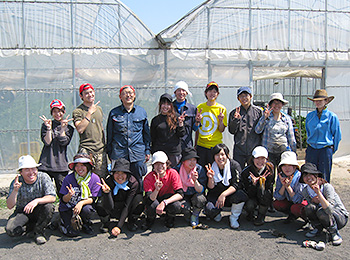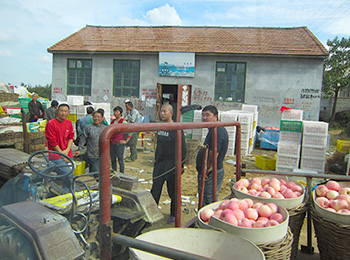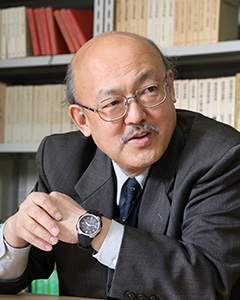

Real-time observation of tumultuous changes following Chinese economic reform
My specialization is socioeconomic research on Chinese agriculture. Rapid economic growth in China has brought about major changes in food supply and social structure in rural villages, resulting in moves toward intensive and varied farming styles. I examine urban–rural disparities and other problems faced by farmers from numerous different angles in order to further explain the states of agriculture in China.
At the Shandong Asahi Green Source High-Tech Farm Co.,Ltd in Laiyang City, Shandong Province. Professor Ikegami’s seminar class visits Chinese villages every year for fieldwork.
Visiting sites in person: a focus on fieldwork
During my 18 years working at the government research center, I spent a total of 6 years in China conducting field studies and research. My first long-term stay in China was in 1988, and I experienced considerable culture shock during that year and a half upon encountering vivid reminders of the planned economy era, a market suffering from a scarcity of goods, and customers bowing their heads and begging shop owners to sell to them. For about two years starting in 1991, I conducted field studies and research at the consulate in Guangzhou. After that, I spent three years starting in 1998 in charge of a Sino-Japanese joint agricultural economy research project in Beijing while also serving as an overall coordinator: This comprehensive research project, which was founded on socioeconomic research, strove for the development of food production technologies as well as relevant food processing techniques. We examined Chinese agriculture from many angles in order to better understand actual conditions and worked to stabilize food supply and demand.
An apple wholesaler in Qixia City, Shandong Province. Planting of vegetables and fruit trees with high added value has been on the rise since the 1990s.
The fascinating experience of analyzing information from various angles
As a form of research, I perform fieldwork-based empirical research using Chinese-language literature, statistical information materials and other documentation. Even since coming to Meiji University I have visited China about five times per year, sometimes taking teams of students with me, and each time I spend about a week actively gathering information from rural homes, farming cooperatives set up between rural households, companies involved in farming work and local governments. Fieldwork is absolutely essential because valuable, on-site information obtained directly from people provides support for the reasoning processes.China has a different government system than that found in Japan, and proper understanding can be difficult until circumstances are properly understood. However, information gathered through on-site experiences fills in the gaps encountered in newspapers, public statistics published by the government, academic papers and other such sources, enabling a truer understanding of underlying conditions.
Because agricultural economics is an empirical science, it is necessary to apply sociology, political science and other fields of knowledge in addition to economics. Furthermore, in consideration of the agriculture’s uniquely high susceptibility to the effects of nature, land conditions and other such factors, an understanding of agricultural technologies is vital, as are acquisition of the local language(s) and heightened sensitivity in regard to socioeconomic and political conditions. These research activities require the collection and analysis of information and the development of reason-based conclusions based on knowledge and various perspectives, which provides constant stimulation of the intellectual curiosity—this is the most appealing aspect of agriculture economics.
The present and future of Chinese agriculture and its many challenges
One of the biggest problems faced by Chinese agriculture is the rapid aging of its members. Today, most young people from farming households move to the city to work, leaving only the elderly and young children back in the villages. During visits to these villages on field survey work, one will rarely encounter anyone in their 20s or 30s. Consideration needs to be given as to how China will muster a central labor force for agricultural work.
Professor Ikegama has continued to devote himself to the precise communication of information since his time at the Ministry of Agriculture, Forestry and Fisheries' research center.
Another issue that deserves attention is the rapid increase in grain import rates that began in 2012. Production of grain in China has been increasing for nine years straight, meaning that the cause of these increased imports seems to be expanding price differences between domestic and overseas markets rather than insufficient domestic supply capacity. The Chinese government has adopted a policy of establishing minimum grain buying prices, and they are raising those prices every year, which appears to have caused a reversal in domestic and overseas prices and resulted in an inflow of low-priced imported grain. If this approach is indeed lowering the international market competitiveness of Chinese grain, then this government policy will certainly not contribute toward the strengthening of domestic agriculture.
In order to ensure Japan’s continued survival, I believe that it is extremely important for us to have a precise understanding of trends in agriculture and farming villages in China, a country with a large land area and population as well as great influence over its neighboring countries.
Similarities and differences between Japanese and Chinese agriculture
Geographic conditions, economic development patterns, economic structure and other close points of similarity exist between Japan and China. In the agricultural realm, cultivated acreage per person is very small, family-owned businesses are the mainstream and business sizes are tiny in both countries. Furthermore, in both cases the comparative advantage of the agricultural industry is declining in response to economic development, the population is aging and the food self-sufficiency rate is dropping. Problems faced by both countries are becoming increasingly similar.However, when examining agricultural development trends in China, we must not overlook the fact that the universal and peculiar aspects of Japanese agriculture are sharply divided. From an international perspective, the Japanese agricultural system and its policies have a great number of unique aspects. I feel that an examination of Chinese agriculture helps to shed light on problematic areas within the Japanese approach, which provides us with valuable information that can be applied to present and future development of Japanese agriculture.
In agriculture as well as other fields, it is vital for Japanese people to compare Japan to other countries when they engage in overseas research, because that type of perspective gives research endeavors a sense of reality and practicability.
Profile
Professor, Department of Agri-food and Environmental Policy, School of AgricultureAkihide Ikegami worked at the National Research Institute of Agricultural Economics, the Japan International Research Center for Agricultural Sciences, and then as an associate professor in the Meiji University School of Agriculture in 2001 before becoming a professor in the same school. He is currently the dean of the Graduate School of Agriculture, and he has a Ph.D. in agriculture from Tohoku University.
Agricultural economics, Chinese agriculture, development economics
Chugoku no Shokuryo Ryutsu Shisutemu (“Grain Marketing System in China,” Ochanomizu Shobo), Shokuryo Kankyo Seisakugaku wo Manabu (“Studying Agri-food and Environmental Policy,” joint authorship, Nihon Keizai Hyouronsha), Chugoku Noson Kaikaku to Nogyo Sangyoka (“Structural Reform of Rural Economy and Change of Agricultural System through Agro-industrialization in Rural China,” joint work, Institute of Developing Economies), Kozochosei-ka no Chugoku Noson Keizai (“ Rural Development and Structural Adjustment in China,” joint work, University of Tokyo Press), Japan Agricultural News newspaper, Kokusai Boeki weekly publication (The Association for the Promotion of International Trade, Japan), others









